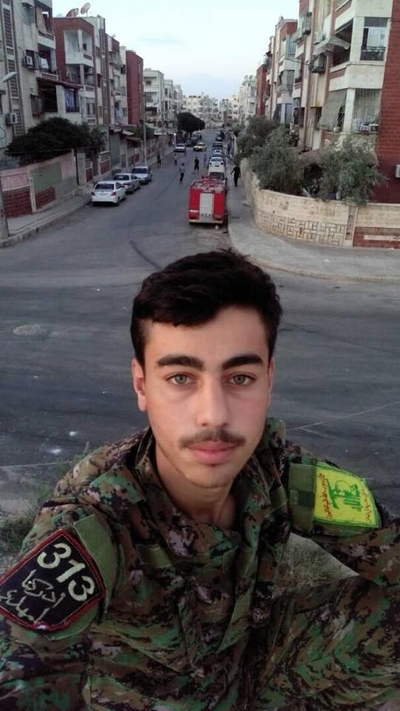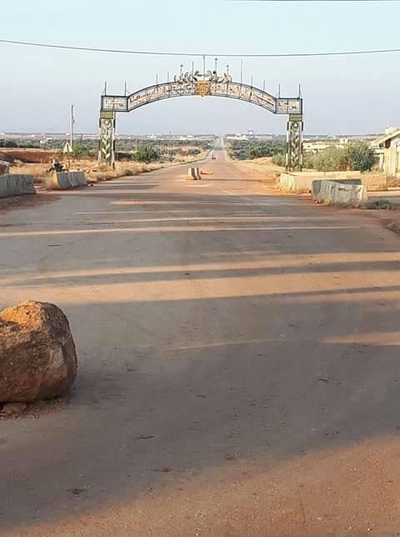The two Shi'i villages of Kafariya and al-Fu'a in Idlib province came to wider media attention on account of international negotiations over the status of their inhabitants, who came under rebel siege following the rebel takeover of almost all of Idlib province in 2015. In July 2018, the last evacuations of the two villages' inhabitants took place.
Yesterday I interviewed Haydara Abu Ridha, who is originally from Kafariya and was among those who left the village. He is currently a member of a formation affiliated with Hezbollah and resides in Hasya in Homs province. As ever, explanatory insertions are in square brackets. The interview has been condensed for clarity.
 Haydara Abu Ridha |
Q: First can you tell me a little about the village of Kafariya? The number of inhabitants and the main families before the war.
A: In Kafariya there were 20,000 inhabitants, and in al-Fu'a there were 30,000 inhabitants.
Q: And who were the biggest families in Kafariya?
A: The Soufan family in Kafariya.
Q: Yes, and was there another big family in Kafariya?
A: The Salum family.
Q: Yes. And roughly how many martyrs has the locality of Kafariya offered during the war?
A: Around 4000 martyrs.
Q: By God? A quarter of the number of inhabitants before the war.
A: Yes. The martyrs from the two villages of al-Fu'a and Kafariya is 20,000 martyrs.
Q: This is the number who have been martyred from the women and children and men?
A: Of course. The biggest incident when we lost martyrs was in al-Rashideen as we were going out.
Q: How many martyrs were martyred in al-Rashideen?
A: 150 martyrs, among children, women and men.
Q: When did the siege on al-Fu'a and Kafariya begin?
A: In July 2015.
Q: And how was life during the siege?
A: Hunger and thirst. A barrel of water was 2000 Syrian pounds, a pack of cigarettes 7000 Syrian pounds. My father and older brother were martyred in Idlib in the war.
Q: Do you remember prices of other foods?
A: 1 kilo of sugar 15,000 Syrian pounds, a packet of ghee 40,000 Syrian pounds, rice 10,000 Syrian pounds, spelt 30,000 Syrian pounds, bulgur 10,000 Syrian pounds, mujadara 16,000 Syrian pounds. This is one kilo.
Q: So for example a kilo of rice 10,000 Syrian pounds?
A: Yes, exploitation...Even the bullets you used in battle, you had to buy them, because there were none available.
Q: You would buy them from arms dealers in Idlib?
A: Yes.
Q: Through smuggling through the areas of the insurgents?
A: Yes.
Q: These dealers were living in the areas of the insurgents in Idlib?
A: Yes.
Q: Didn't food goods come through helicopter sometimes? I mean Syrian government helicopter.
A: Yes, but each week it would come such that there would be 300 grams for each person. How would they make do with that?
Q: By God it does not suffice, true.
A: I have my family of 3 martyrs- my father, brother and sister. And my younger brother wounded with fracture in the skull and my mother with wounds in the head.

Q: Yes. What was distributed by the helicopter? Bread and medicines for example?
A: Yes, and rice. Just that.
Q: Yes. What was the role of the friends (Islamic Resistance- Hezbollah and the Iranian side) in supporting al-Fu'a and Kafariya during the siege?
A: Yes, only with money.
Q: But there were some fighters from Hezbollah who came to al-Fu'a and Kafariya through helicopter, correct?
A: Correct.
Q: As for the Iraqi brothers they did not come to al-Fu'a and Kafariya to help you?
A: There were no Iraqis in Kafariya and al-Fu'a, no...But they tried to open the way to al-Fu'a and Kafariya.
Q: You told me the friends helped you with money. Do you mean they paid the salaries of the mujahideen defending al-Fu'a and Kafariya?
A: Yes, and simple aid for the civilians.
Q: Yes. So you for example were within a formation affiliated with Hezbollah inside Kafariya?
A: No. I had weapons. I would only go out when there were clashes.
Q: Yes. As for the fighters who were always on ribat [manning the frontlines], they were in a formation affiliated with Hezbollah?
A: Yes, [affiliated with] Hezbollah.
Q: Was there a specific name for the formation?
A: No.
Q: When it was decided to evacuate all the inhabitants of the two villages, were you for the decision or against it?
A: Against it, of course.
Q: And most of the inhabitants of the two villages were against the evacuation?
A: Yes.
Q: Why? Wasn't life difficult under the siege?
A: Yes, but it is the land [i.e. our land]. And the land is precious.
Q: Yes. There is nothing more precious than your land.
A: Of course, there is nothing [more precious].
Q: Currently in which areas are most of the people of al-Fu'a and Kafariya?
A: Hasya [in Homs] and al-Basit [in Latakia].
Q: Do you expect that after liberating Idlib from the insurgents the people in Idlib can return to peaceful co-existence? Because we have seen much sectarian hatred from the insurgents and their supporters against the Shi'a in Idlib.
A: Brother, there's no sweetness in us anymore. Enough: blood has arisen between us. On top of all this they have destroyed the graves.
Q: Yes. So it's necessary to take revenge?
A: It is so.
-----------------------------------------
Notes
- The figures given in the interview for the number of people from al-Fu'a and Kafariya who have been killed during the war are almost certainly large overestimates. For comparison, another source from the area gives a much more realistic estimate of around 3000 'martyrs' from al-Fu'a and Kafariya. That statistic includes people killed defending the two villages, civilian deaths, and fighters originating from the two villages who have died in battles elsewhere in Syria (e.g. in the push by the Syrian government and its allies towards Deir az-Zor and the borders with Iraq).
In general, there has been much talk of the war's impact on the Alawite coastal communities, whereas the subject of the war's impact on Syrian Shi'i communities remains understudied.
- Besides Hasya and al-Basit, people from al-Fu'a and Kafariya are also residing in Aleppo (incl. the two Shi'i villages of Nubl and Zahara') and Damascus (incl. the Sayyida Zainab area). One of the original proposals behind evacuations of al-Fu'a and Kafariya was an evacuation for residents and rebels of besieged Madaya and al-Zabadani who did not wish to come under Syrian government control. No evidence shows that former residents of al-Fu'a and Kafariya have settled in any meaningful numbers in Madaya and al-Zabadani.
- The Hezbollah presence in al-Fu'a and Kafariya: the most notable Hezbollah member from Lebanon who was deployed to al-Fu'a and Kafariya was Jamil Faqih. Faqih joined Hezbollah in 1996 and participated in the 2006 war against Israel. He was said to have received the Hezbollah portfolio for al-Fu'a and Kafariya and was killed in July 2015. His body was initially buried in the area before being transferred in 2017 to be buried in al-Tairi in south Lebanon.
Following the final evacuation of al-Fu'a and Kafariya, six Hezbollah personnel from Lebanon were reported to have reached the Sayyida Zainab area of Damascus before returning home to Lebanon. They were said to have been in al-Fu'a and Kafariya since the siege began in 2015. This point supports the account of an al-Fu'a and Kafariya news post from July 2015, which denied some pro-opposition claims of entire combat groups of Lebanese Hezbollah fighters inside the besieged villages, noting instead that the Hezbollah presence amounted to the presence of some individuals, and no more. Of course, these Hezbollah personnel would have advised local fighters and helped train them and support them financially.
There is no evidence to suggest that Iraqi, Afghan or Pakistani Shi'i fighters deployed to al-Fu'a and Kafariya.

